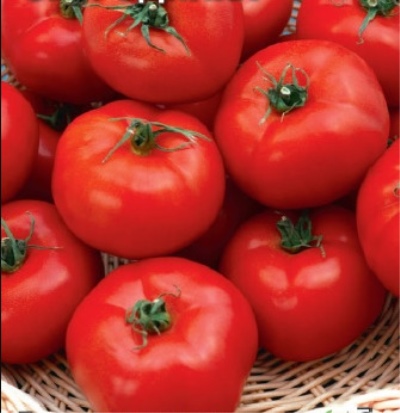
- Authors: Lukyanenko A. N., Dubinin S. V., Dubinina I. N. (Agrofirm Sedek LLC)
- Year of approval: 2007
- Category: grade
- Growth type: determinant
- Appointment: universal
- Ripening period: early
- Ripening time, days: 95-105
- Growing conditions: for open ground, for film greenhouses
- Transportability: high
- Bush size: undersized
The gardener's dream tomato is a determinant universal variety that has earned the attention of summer residents due to its outstanding fruiting abilities. It is focused on non-commercial planting, suitable for use in salads, fresh eating. The variety is zoned for most regions of the Russian Federation, it can be planted under a film or in open ground.
Breeding history
The variety was bred by the specialists of Agrofirma Sedek LLC. Passed state tests, approved for use since 2007.
Description of the variety
Tomato bushes of this variety are undersized, in the open field they grow no higher than 60-70 cm, in a greenhouse this indicator differs by 100-150 mm in a larger direction. Their leafiness is average. The leaves on the bushes are green, bright, small. The inflorescence is simple, the stalk is articulated. Up to 5 racemes are formed on the powerful main stem.
The main qualities of the fruit
The Gardener's Dream variety gives tomatoes with a smooth glossy skin, when ripe they are red. Tomatoes have a flat-round shape, collected in a cluster of 4-6 fruits. Each weighs up to 80 g. The pulp of this variety is fleshy, medium-dense. Outwardly, tomatoes look attractive, they are well stored without losing their juiciness and mass.
Taste characteristics
The fruits have a balanced taste, good, with a sufficient degree of sweetness. The concentration of lycopene in them is above average.
Ripening and fruiting
The variety is early, its fruits ripen in 95-105 days from the moment of germination. Harvesting takes place from July to September. Fruits ripen together, in 1 wave up to 70% of the total harvest is harvested.
Yield
Tomato bushes produce fruits up to 6.3 kg / sq. m. Fruit collection is facilitated by the special structure of the stalk.
The timing of planting seedlings and planting in the ground
Tomato seeds A gardener's dream begin to be sown in special containers or cassettes at the end of March or in the 1st decade of April. It is not customary to sow them directly into open ground. Plants are transplanted to a permanent place in open ground in late May - early June, after the end of the traditional spring frosts. On average, it takes about 60 days from the moment of sowing the seeds to it.

Growing tomato seedlings is an extremely important process, because it largely depends on whether the gardener will be able to harvest at all. All aspects must be taken into account, from seedbed preparation to planting in the ground.
Landing scheme
The distance between plantings recommended by the originators is 40-50 by 70 cm. 3-4 plants can be placed on each square meter.

Growing and care
The Gardener's Dream tomato forms relatively compact bushes that lead to 1-2 stems. Due to the significant fruit load, the shoots have to be tied up in order to protect them from damage.And also the removal of stepsons requires attention - they are formed very abundantly, they require manual cutting.
The readiness of a plant for transplantation is usually determined by the bush reaching a height of 12-15 cm. At this stage, the bush already has 5-6 true leaves, the first flower brushes may appear. Experienced summer residents are advised to immediately sow seeds in separate containers, choosing peat pots. So when transplanting, the plants will be minimally injured.
Soil preparation consists in digging up the selected place, as well as in applying fertilizers. All this happens no later than 14 days before landing. The plants themselves in the same period are gradually hardened, taking them out into the open air for several hours, bringing the duration of exposure to 10-12 hours.
The main care of plants after transplanting is to maintain optimal moisture, looseness of the soil. Watering is adjusted according to weather conditions. On average, a suitable regime can be called the introduction of moisture 2 times a week. Up to 5 liters of warm water is added under each bush.
Top dressing is carried out starting from the 10th day after transplanting plants into open ground. Nitrogen fertilizers, complex, water-soluble, are applied under the root. Then comes the time of potassium-phosphorus compositions. Funds are deposited alternately every 2 weeks.
In order to reduce the need for watering shrubs, you can carry out a thorough mulching of the soil. The layer of sawdust, straw or other natural material must be changed regularly. At the same time, the soil is subjected to loosening, weeding. All this will allow plants to grow and develop fully.




A plant needs different micronutrients at each stage of growth. All fertilizers can be divided into two groups: mineral and organic. Folk remedies are often used: iodine, yeast, bird droppings, eggshells.
It is important to observe the rate and period of feeding. This also applies to folk remedies and organic fertilizers.
Disease and pest resistance
The variety demonstrates genetic resistance to the development of top rot, root infections. And it is also indicated that the variety is not prone to damage by fusarium, verticillosis, TMV and late blight. High immunity helps plants to produce fruits without the risk of loss of yield. In the open ground, the bushes are also not threatened by pests.


Resistant to adverse weather conditions
The gardener's Dream variety is well adapted for growing in regions with strong winds, scorching sun or high precipitation. It is resistant to drought and waterlogging; with proper agricultural technology, external factors do not affect the abundance of fruiting.

























































































